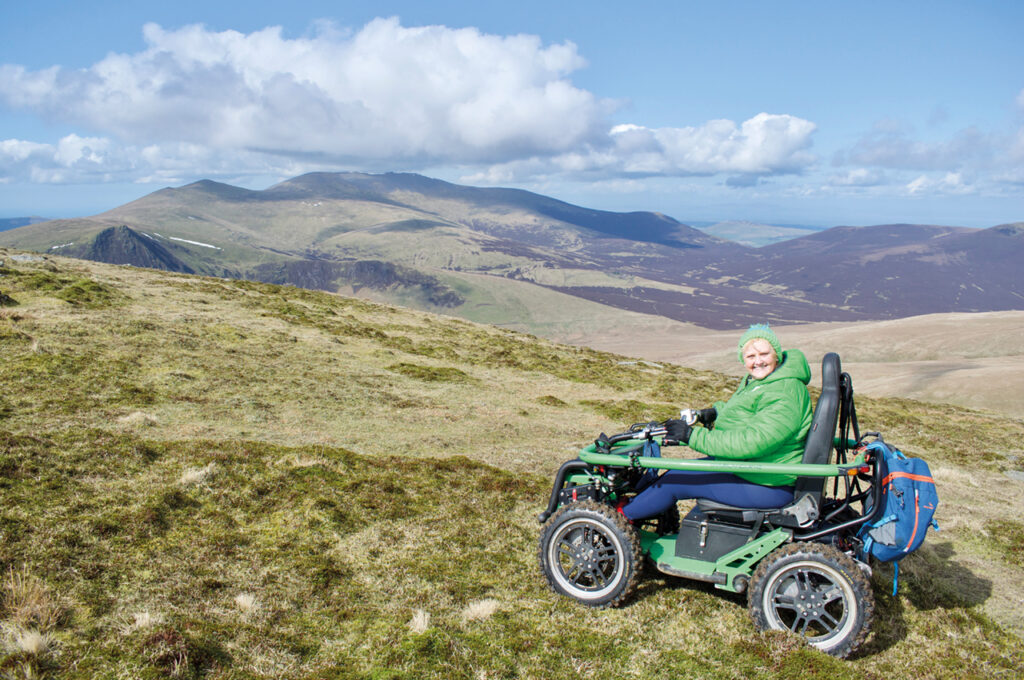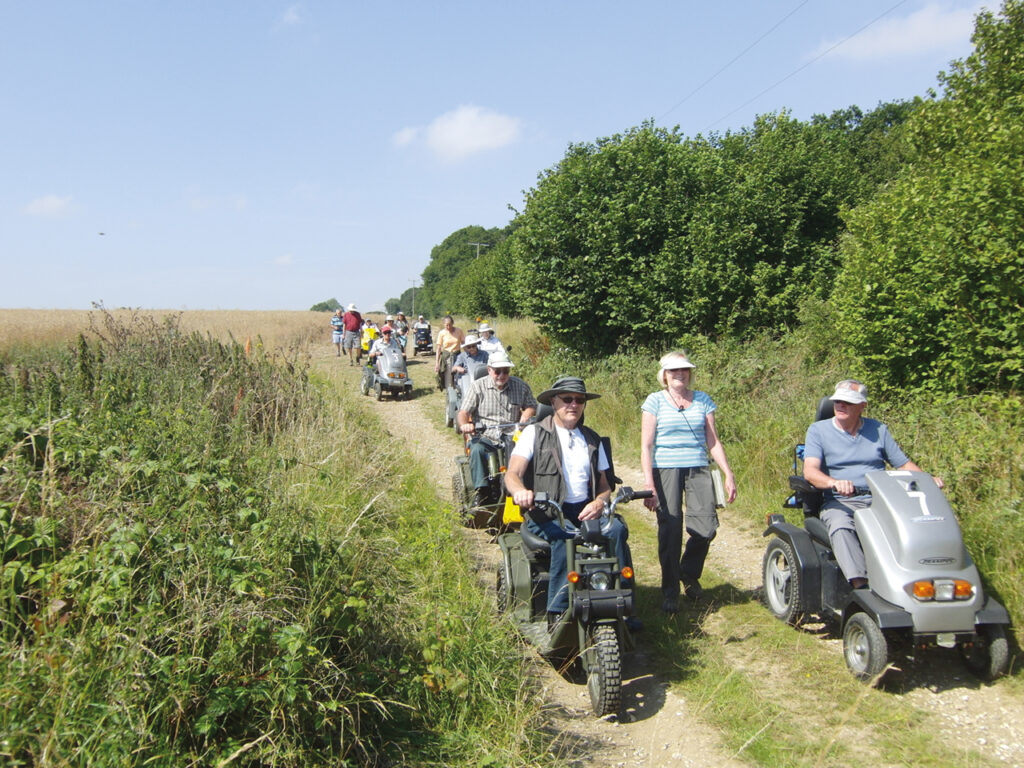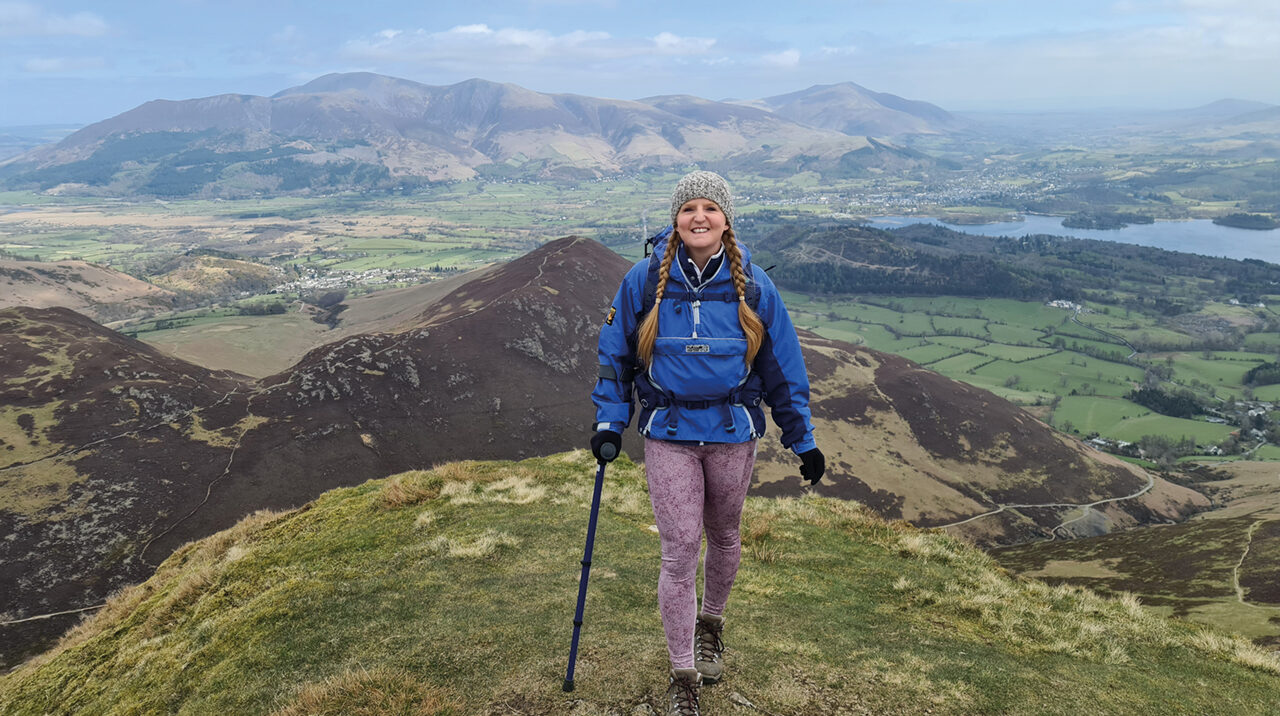Summit gains
Last year Sarah Curran walked the 79-mile Cumbrian Way after fearing she’d never hike again. These special moments were made possible by disability campaign efforts to make the countryside accessible
There is a renewed appreciation for the great outdoors, not only as a cost-effective pastime but one that has a plethora of benefits for our physical and mental health.
Just last December, a series of reviews commissioned by Natural England and NHS England found “exposure to nature” increased subjective wellbeing, happiness and resilience and reduced social isolation.
However, while the UK’s lakes, hills, mountains and dales are available to all, they are not accessible to everyone, especially those who are disabled or have limited mobility.
Debbie North, a former primary headteacher from Northallerton, Yorkshire, has been campaigning to make the countryside more inclusive for over a decade.
“Things are improving but it is very slow. It’s like pulling teeth, but I never stop banging on about access for all in the countryside. As the CEO of Yorkshire Dales National Park kindly said to me the other week, ‘You are a pain in my side but a very useful pain,’” says North, who was diagnosed with degeneration of the spine in 2010 and uses a wheelchair for mobility.
“Before the diagnosis, I was a keen hillwalker and my late husband and I would always be out on the fells at the weekend. To have that taken away was devastating.”
Now with the aid of her Tramper – an all-terrain mobility scooter – North says she can go up mountains and enjoy days out. But they are expensive, not only to buy (£5,000-£17,000) but to store and transport.
It’s why North set up Access the Dales, a charity that provides all-terrain wheelchairs for free use in locations across the Yorkshire Dales. Like Countryside Mobility and Lake District Mobility it aims to make the countryside more accessible.
“Very often it’s an able-bodied person making the decisions on behalf of those with disabilities, instead of discussing what is needed and how those needs can be facilitated with the very people who are directly impacted,” says North, who is an Ordnance Survey GetOutside Champion and in June was appointed by the Cabinet Office as disability and access ambassador for the countryside.
“I focus on mobility because that is what affects me personally, but I am intrigued to learn about how to access the countryside if you are visually impaired, or have dementia, severe learning difficulties or autism, for instance.”
North says that until someone is faced with a disability themselves, it is difficult to comprehend the obstacles.
“I’ve seen people switch off when I’m talking because it doesn’t affect them – until it does. As one man informed me, he didn’t get what I was talking about until he needed a hip replacement. But I think people are getting much more used to seeing disabled people on TV and in the media, and the more exposure there is, the more inclusive we will become as a society.”
But it can be a hard slog at times. North has been trolled on social media by people accusing her of “wanting to concrete the whole of the UK”.
“One idiot even wrote the next thing I’ll want is a Stannah stairlift up Scafell Pike. I have to put it down to the ignorance of what accessibility is all about. It’s not about changing the landscape – it’s about using the technology that’s already there to ensure our beautiful countryside can be accessed by all, rather than only those who can afford it,” says North.

“There is still an awful lot to be done, from working with farmers and landowners to remove barriers, such as stiles, and spreading the word about positive practises around the country, to working with organisations so accessibility isn’t simply treated as a bolt-on or after-thought. It’s why I am going to keep complaining and keep knocking at those doors.”
According to disability charity Scope, there are 14.6 million disabled people in the UK – one in five. Around 40 per cent of households have at least one disabled person and 42 per cent of pension age adults are disabled.
This is a huge proportion of the population, whose needs are often sidelined or ignored. This includes access to the nourishing benefits of nature.
“I still remember the first time my wife was able to get back on to the summit of the Malvern Hills,” says John Cuthbertson, chairman of the charity Disabled Ramblers. “She hadn’t been up there for nine years. Just the elation of that moment of achieving a summit gain was wonderful to behold.”
Cuthbertson and his wife Liz became members of Disabled Ramblers in 2009, initially because of Liz’s disability, although he now suffers from chronic obstructive pulmonary disease – a lung condition that can cause breathing difficulties, meaning he can’t walk far himself these days.
“We’ve got people who have suffered from polio, have arthritis, missing limbs, all sorts of diseases and ailments, and some who have just got old. Our Facebook page has got about 2,000 members across the country where people can ask questions and talk about issues,” he says.
The group also organises a ramble programme for members from April to October, with a number of Trampers for people to hire. This year, gatherings will include the North York Moors, Derbyshire and Cheshire.
“We’ve got a fantastic right of way network across the country, but only a small proportion of that is accessible to people on mobility scooters,” says Cuthbertson. “The cost of making changes can put farmers, landowners and land managers off but quite often the local council will provide the equipment and volunteers will install it. But councils across the country are strapped for cash, so it’s got to come from the top – for the government to recognise the value of the countryside. If you make it accessible for the disabled, it’s accessible for everyone.”
Scope has found that, on average, disabled people face extra costs of £583 a month related to their condition (on top of welfare payments designed to help meet these costs). They are also almost twice as likely to be unemployed.
“Generally, people with disabilities are poorer because life can be more expensive on a day-to-day basis,” says Sarah Garman, business development manager at Bendrigg Trust in Cumbria, a charity that provides outdoor adventure activities for people with disabilities and from disadvantaged backgrounds.
“A lot of places are now saying they are accessible and inclusive. That might mean they have an accessible toilet, but there are not many places like Bendrigg. No matter what your disability is, you can take part in activities.
“For example, some people have to be connected to oxygen at all times, but they can still go down our zipwire, or wheelchair users can go in a canoe on Lake Windermere and that’s because of the adaptations we have and the skill of our instructors.
“It’d be great if, at some point in the future, you didn’t have to have specialist centres and everybody was set up to support any kind of ability, but at the minute, we are one of a very small handful of specialist centres and people travel from all over to use our facilities.”
Financial sustainability is understandably an ongoing challenge for Bendrigg Trust and donations are vital.
“We need around half a million pounds every year to keep going. I think that’s going to increase in the coming years because disabled people have been disproportionately affected by Covid and the cost-of-living crisis, so finances are skewed anyway for the people we support. We’re looking to step up our own support, to help subsidise visits, and make sure we can be there to help, so finances aren’t a barrier for people.”
The team is also focusing on education and disability training. “Places are trying to be more inclusive now and that is fantastic because it will open up more opportunities for people,” says Garman. “If we can support local businesses to be more accessible and inclusive, then more people with disabilities will be able to visit the area and that can only be a good thing.”

Sarah Curran, 34, works in IT in Keswick. In 2015, she rolled her left ankle back while in the RAF, resulting in an osteochondral defect. She is now an ACAI outdoorwear ambassador. “I used to be an avid runner, so when I was told I’d never run again it devastated me. I sank into a depression and put on a lot of weight.
“In early 2017, my parents encouraged me to walk up Loughrigg Fell in Cumbria. I didn’t think I could do it as I was still on two crutches, but I did and it felt amazing. It’s why I decided to focus my energy on hiking and last June hiked the 79 mile Cumbria Way over five days.
“When I’m hiking, I just focus on putting one foot in front of the other and enjoy the views. You feel such a sense of freedom and achievement. Just take it slow, and plan. Look at the route in advance, identify any concerns, alter the route if needed and have contingencies in case you need to head back early.”
Anisah Barber, 26, from Derby, suffers from the autoimmune disease lupus SLE, fibromyalgia and hypermobility spectrum disorder. She is the founder of Outside Our Way, an online community for outdoor disability inclusion.
“I was fed up of being limited and terrified of leaving the house because of my disability, so I thought I’d just go out and do something I didn’t think I could do. I fell in love with the outdoors, especially hiking.
“The biggest impact is on my mental health. I feel so proud of the body that usually holds me back and hurts and being in nature is rejuvenating in itself.
“My advice is, take your time. Start with short flat walks and build up the intensity at your own pace. There’s a lack of representation, and a lack of advice and information on accessing the outdoors with mobility issues. Disability is such a huge and varied group and disabled folks need to be part of the discussion.”
Steve Johnson, 58, from Southport, had his leg amputated at 21. He leads the England Amputee Football Association and is disability manager at Everton in the Community.
“When the Covid lockdown was brought in, I realised just how greatly the outdoors benefited me as the restrictions stopped me from participating in team sports. So I purchased an electric bike which allowed me to go on woodland trails near where I live. I felt a huge shift in my mood from simply being outside and an improvement in myself, both mentally and physically.
“Unless you work with disabled people or have a relative with a disability, it can be difficult for non-disabled people to understand some of the barriers those with disabilities face. It would be a step in the right direction to have more visibility of outdoor activities for disabled people outside things such as the Invictus Games and the Paralympics.
“Adapting the environment to cater for disabled people’s needs is a start. Taster sessions would also encourage people to get involved with sessions without the fear of losing out financially.”
Reaping nature’s benefits doesn’t have to involve scaling mountains. Sometimes an amble to the local park can be just the pick-me-up that’s needed. But just as lockdowns shone a light on the need for green spaces, it also highlighted the inequality of access to these areas, especially in economically deprived areas. This can have a particularly detrimental impact on disabled people who might not have the means or desire to travel further.
“We appreciate there are increasing demands on local council budgets, but the decline of these spaces, which offer so many health and wellbeing benefits alongside a space for community building, is unfair, particularly to those who can’t access other means of getting active,” says Mikey Erhardt who works on the Get Yourself Active programme at Disability Rights UK.
“We all have to ensure local authorities are reminded of the crucial importance of local green spaces for all who can use them and incorporate a rights-based approach to planning, designing and managing urban green and blue spaces that combats existing inequities.”
He references the work being done by environmental organisations as part of the Nature for Everyone campaign, but notes sometimes it only takes one person to produce real change.
“We recently heard from a woman who successfully campaigned for her local park to become more accessible by installing a perimeter path, so she could use the park from her mobility scooter all year round. Her petition and hard work led directly to the park being awarded Green Flag status. So one way you can support is by contacting your local councillor to ask about existing local schemes to improve access to green spaces or to enquire about setting one up.”

Leave a reply
Your email address will not be published.